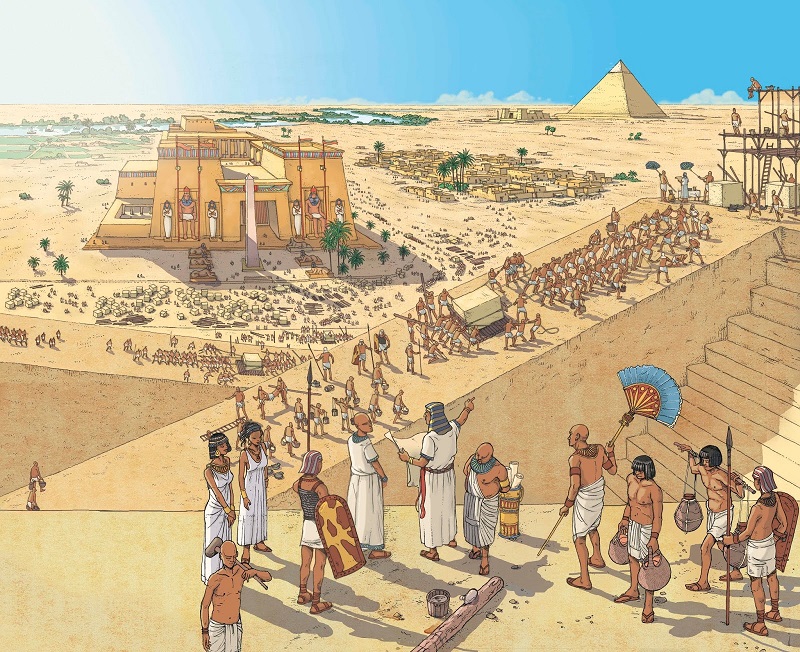Ancient Building Methods
The stones used in building the Pyramids were massive, some as large as modern semi-trailer trucks. They were quarried from limestone and granite quarries hundreds of miles south of the Giza plateau and transported north along the Nile River before being moved to the construction site by land. Once there, the builders faced the immense challenge of lifting and positioning these multi-ton stone blocks, some as heavy as 70 tons, at the ever-increasing heights of the structures. Various theories have attempted to explain the advanced engineering required. Ramps were certainly involved, as the builders needed a way to move the blocks up the faces of the pyramids. Ramp systems have been proposed that wrapped around the structures or extended outward from them. But these may not have been sufficient for transporting the largest granite monoliths. Another possibility is that the builders leveraged simple mechanical advantages using ropes, logs, and manpower to gradually “walk” the blocks up makeshift scaffolding.
![]()
Block by Block
My own theory, proposed in 1996, suggested raising the monoliths one level at a time. As each new course was constructed, a small internal ramp could be built to pull the largest stones to that height. They would then be stored on the upper level until their final positions within the chambers. With incremental vertical progress and ample working space maintained during construction, this “block shuffle” approach may have enabled the giant stones to reach their destinations without complicated angled ramps. Subsequent research has led me to think external ramp systems were indeed used for most stones. But moving granites posed unique challenges. My block-by-block idea addresses how they could have been precisely placed inside the pyramid as it rose without needing enormous cranes or alien technology. Standard work crews of 30-50 men apiece, pulling and leveraging with reeds and ropes, may have sufficed.
A Crewed Effort
Estimates put the total construction workforce around 30,000, with perhaps 10% focused on transport. With 50 laborers per crew and 60 crews working simultaneously each day, a single block could be relocated every 2 hours on average. Over the 25-year building period, that pace equates to roughly 300 blocks per day—enough to complete the entire pyramid before the pharaoh’s death. Organisation and planning were clearly vital to marshaling thousands of workers. Strict routines and hierarchies would have ensured steady productivity without delays. Water and provisions also needed ongoing logistical support for multi-decade projects in the Egyptian desert. Through intensive labor and resource management, the results of their efforts still stand as engineering marvels defying modern comprehension.
Engineering Wonders
Upon close inspection, the precision-cut blocks forming the pyramids reveal an unmatched knowledge of architecture, stonemasonry, and mathematics. Their multiple interior chambers and narrow shafts leading to the outside imply sophisticated design and construction techniques. Even minimal erosion after millennia attests to the durable materials selection and skilled craftsmanship involved.
How exactly did an ancient civilization develop such advanced technical abilities? Further archaeological evidence from their tools, settlements, and other ruins provides clues about long-term societal development. Over generations, incremental improvements to quarrying, metalworking, and lifting methods allowed increasingly ambitious projects. Through this gradual, multi-generational progress, the pyramid builders perfected skills leading to their renowned creations.
The true extent of the pyramids’ engineering and construction challenges still inspires wonder today. While full understanding may elude us, analyzing surviving records alongside each site grants new appreciation for these marvels and the remarkable people who built them. Their accomplishments stand as a testament to what focused human ingenuity is capable of, even within primitive material constraints.
Lasting Mystique
Though modern science has provided many answers, unresolved questions ensure the pyramids retain an air of mystery. How exactly were the heaviest stones maneuvered without advanced lifiting technologies? What was the full organizational structure coordinating builders and supplies? Unclear points invite ongoing scholarship and hypotheses to piece together this unprecedented episode in history.
The enigma surrounding their construction has also fueled outlandish theories over the centuries. While notions of extraterrestrial aid or hyper-advanced lost civilizations make for exciting fiction, careful analysis of artifacts and surroundings reveals mundane causes aligned with our knowledge of ancient Egyptian capabilities. Nonetheless, not having a complete blueprint for their engineering marvels leaves room for imagination to fill in gaps and further fuel the pyramids’ mystique. Their impressive grandeur and persistence over millennia cement their deserved place among the most legendary monuments ever built by human hands.

/f/53624/1400x430/dcd648f176/6-egyptian-wonders-beyond-the-pyramids.jpg) Exploring Egypt Beyond the Pyramids
Exploring Egypt Beyond the Pyramids